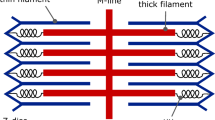Abstract
This short overview of the mechanical properties of smooth muscle focusses on the force–velocity relation of (mainly pig urinary bladder) smooth muscle, and its dependence on the length of the muscle and its degree of activation. Also the response of the muscle to length and force changes at a rate beyond the physiological range is discussed. The force–velocity relation of this type of muscle can be approximated by the hyperbolic Hill equation, with a normalised maximum shortening velocity in the order of 0.25 muscle lengths/s. As in striated muscle, the maximum isometric force depends on the stretched muscle length and shows a maximum at a certain length. Interestingly, smooth muscle does not normally seem to operate at this length, but far below it. Both the isometric force and the unloaded shortening velocity depend on the degree of activation of the muscle, and so does the ‘curvature’ of the Hill equation. The series elasticity of the muscle, which can be measured by applying length changes at a rate beyond the physiological shortening velocity, is found partly in the cross-bridges, and partly external to these. An isometric quick release of 4–10% of the muscle length is necessary to remove all tension, depending on the total force exerted by the muscle. Force recovery after such a release is biexponential in a 700 ms window. The slowest component of this recovery, with a time constant in the order of 0.45 s is mainly associated with cycling of the cross-bridges, the fastest with the external series (visco) elasticity. Isometric force development has a time constant in the order of 3 s. indicating that excitation–contraction coupling rather than cross-bridge cycling is rate limiting in this process.
Similar content being viewed by others
References
Ganitkevich V, Hasse V and Pfitzer G (2002) Ca2+-dependent and independent regulation of smooth muscle contraction. (this issue).
Hellstrand P (1979) Mechanical and metabolic properties related to contraction in smooth muscle. Acta Physiol Scand Suppl 464: 1–54.
Hellstrand P and Johansson B (1979) Analysis of the length response to a force step in smooth muscle from rabbit urinary bladder. Acta Physiol Scand 106(2): 221–238.
Hill AV (1938) The heat of shorteningand the dynamic constants of muscle. Proc R Soc Lond B Biol Sci 126: 136–195.
Huxley AF (1974) Review lecture: Muscular Contraction. J Physiol (Lond) 243: 1–43.
Johansson B (1984) The contractile machinery and mechanics of contraction. J Cardiovasc Pharmacol 6(Suppl 2): S313-S319.
Kong SK and Stephens NL (1983) Mechanical properties of pulmonary arteries from sensitized dogs. J Appl Physiol 55: 1669–1673.
Lofgren M, Malmqvist U and Arner A (2001) Substrate and product dependence of force and shorteningin fast and slow smooth muscle. J Gen Physiol 117: 407–418.
Malmqvist U, Arner A and Uvelius B (1991) Mechanics and Ca(2+)-sensitivity of human detrusor muscle bundles studied in vitro. Acta Physiol Scand 143: 373–380.
Mashima H, Okada T and Okuyama H (1979) The dynamics of contraction in the guinea pig taenia coli. Jpn J Physiol 29: 85–98.
Meiss RA (1978) Dynamic stiffness of rabbit mesotubarium smooth muscle: effect of isometric length. Am J Physiol 234(1): C14-C26.
Minekus J and van Mastrigt R (2001) Length dependence of the contractility of pigdetrusor smooth muscle fibres. Urol Res 29: 126–133.
Minekus Joanne, Visser Anja and van Mastrigt R (2001) Supramaximal stimuli do not evoke a maximal contraction in urinary bladder smooth muscle fibres. Urol Int 67: 62–68.
Moriya M and Miyazaki E (1985) Force-velocity characteristics of stomach muscle: a comparison between longitudinal and circular muscle strips. Comp Biochem Physiol A 81(3): 531–537.
Mulvany MJ (1984) Cross-bridges in smooth muscle. In: Stephens, NL (ed.) Smooth Muscle Contraction. (pp. 145–150) Marcel Dekker, New York.
Stephens NL (1985) Force-velocity constants in smooth muscle: afterloaded isotonic and quick-release methods. Can J Physiol Pharmacol 63(1): 48–51.
Stephens NL, Seow CY, Halayko AJ and Jiang H (1992) The biophysics and biochemistry of smooth muscle contraction. Can J Physiol Pharmacol 70: 515–531.
Uvelius B (1977) In.uence of muscle length on the force-velocity relation of K+-contractures in smooth muscle from rabbit urinary bladder. Acta Physiol Scand 101(3): 270–277.
Uvelius B (1979) Shorteningvelocity, active force and homogeneity of contraction duringelectrically evoked twitches in smooth muscle from rabbit urinary bladder. Acta Physiol Scand 106: 481–486.
Uvelius B and Hellstrand P (1980) Effects of phasic and tonic activation on contraction dynamics in smooth muscle. Acta Physiol Scand 109: 399–406.
van Koeveringe GA (1997) Dynamics of smooth muscle contraction. Thesis Erasmus University Rotterdam.
van Koeveringe GA and van Mastrigt R (1991) Excitatory pathways in smooth muscle investigated by phase plot analysis of isometric force development. Am J Physiol 261: R138-R144.
van Mastrigt R (1988) Length dependence of series elasticity of pig urinary bladder smooth muscle measured with a multiple quick release technique. J Muscle Res Cell Mot 9: 525–532.
van Mastrigt R (1991) The force recovery following quick releases applied to pigurinary bladder smooth muscle. J Muscle Res Cell Mot 12: 45–52.
van Mastrigt R (1999) The volume dependence of maximum flow rates revisited. Neurourol Urodyn 18: 367–368.
van Mastrigt R (2000) The bladder output relation: dependence on degree of activation. Abstracts ICS 2000 Tampere, Finland. p. 232.
van Mastrigt R and Glerum JJ (1985a) In vitro comparison of isometric and stop-test contractility parameters for the urinary bladder. Urol Res 13: 11–17.
van Mastrigt R and Glerum JJ (1985b) Electrical stimulation of smooth muscle strips from the urinary bladder of the pig. J Biomed Eng 7–1: 2–8.
Wang Z and Stephens NL (1989) Normally cyclingand latch bridges in venous smooth muscle. Blood Vessels 26: 272–279.
Author information
Authors and Affiliations
Rights and permissions
About this article
Cite this article
Van Mastrigt, R. Mechanical properties of (urinary bladder) smooth muscle. J Muscle Res Cell Motil 23, 53–57 (2002). https://doi.org/10.1023/A:1019936831366
Issue Date:
DOI: https://doi.org/10.1023/A:1019936831366




